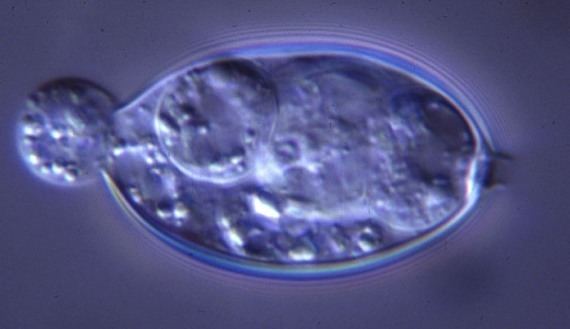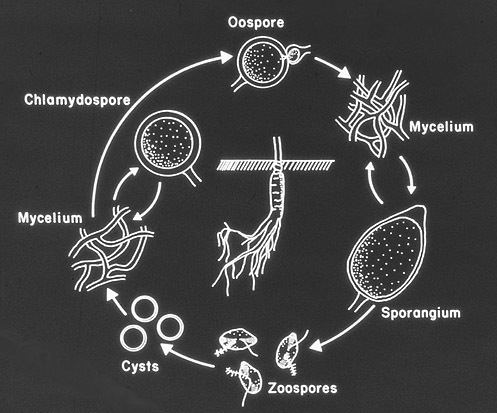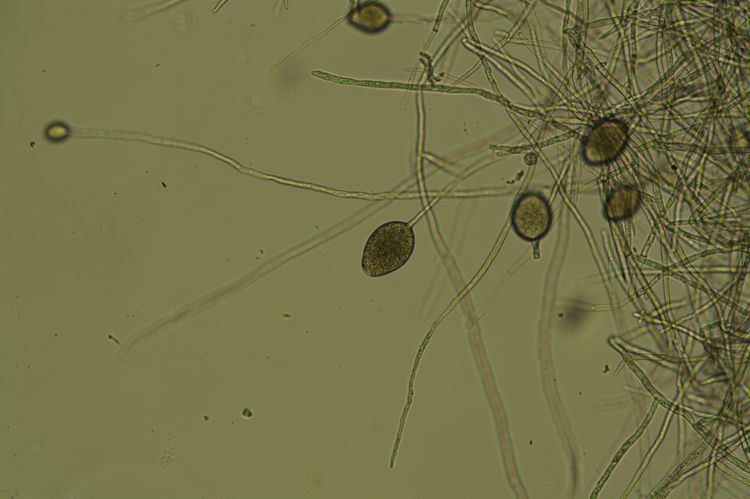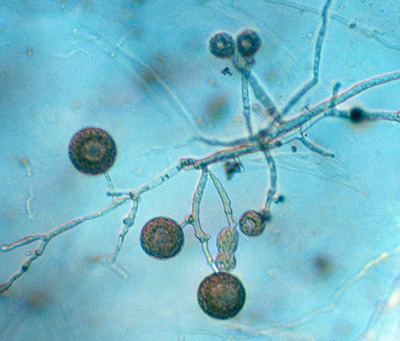Domain Eukaryota Scientific name Oomycetes Higher classification Heterokont | ||
 | ||
Lower classifications | ||
Releasing oospores from oogonium oomycetes
Oomycota or oomycetes (/ˌoʊəˈmaɪsiːts/) form a distinct phylogenetic lineage of fungus-like eukaryotic microorganisms. They are filamentous, microscopic, absorptive organisms that reproduce both sexually and asexually. Oomycetes occupy both saprophytic and pathogenic lifestyles, and include some of the most notorious pathogens of plants, causing devastating diseases such as late blight of potato and sudden oak death. One oomycete, the mycoparasite Pythium oligandrum, is used for biocontrol, attacking plant pathogenic fungi. The oomycetes are also often referred to as water molds (or water moulds), although the water-preferring nature which led to that name is not true of most species, which are terrestrial pathogens. The Oomycota have a very sparse fossil record. A possible oomycete has been described from Cretaceous amber.
Contents
- Releasing oospores from oogonium oomycetes
- Fifi the oomycete
- Morphology
- Phylogenetic relationships
- Classification
- Etymology
- Reproduction
- Pathogenicity
- References

Fifi the oomycete
Morphology

The oomycetes rarely have septa (see hypha), and if they do, they are scarce, appearing at the bases of sporangia, and sometimes in older parts of the filaments. Some are unicellular, but others are filamentous and branching.
Phylogenetic relationships

This group was originally classified among the fungi (the name "oomycota" means "egg fungus") and later treated as protists, based on general morphology and lifestyle. A cladistic analysis based on modern discoveries about the biology of these organisms supports a relatively close relationship with some photosynthetic organisms, such as brown algae and diatoms. A common taxonomic classification based on these data, places the class Oomycota along with other classes such as Phaeophyceae (brown algae) within the phylum Heterokonta.

This relationship is supported by a number of observed differences in the characteristics of oomycetes and fungi. For instance, the cell walls of oomycetes are composed of cellulose rather than chitin and generally do not have septations. Also, in the vegetative state they have diploid nuclei, whereas fungi have haploid nuclei. Most oomycetes produce self-motile zoospores with two flagella. One flagellum has a "whiplash" morphology, and the other a branched "tinsel" morphology. The "tinsel" flagellum is unique to the Kingdom Heterokonta. spores of the few fungal groups which retain flagella (such as the Chytridiomycetes) have only one whiplash flagellum. Oomycota and fungi have different metabolic pathways for synthesizing lysine and have a number of enzymes that differ. The ultrastructure is also different, with oomycota having tubular mitochondrial cristae and fungi having flattened cristae.
In spite of this evidence to the contrary, many species of oomycetes are still described or listed as types of fungi and may sometimes be referred to as pseudofungi, or lower fungi.
Classification
Previously the group was arranged into six orders.
However more recently this has been expanded considerably.
Etymology
"Oomycota" means "egg fungi", referring to the large round oogonia, structures containing the female gametes, that are characteristic of the oomycetes.
The name "water mold" refers to their earlier classification as fungi and their preference for conditions of high humidity and running surface water, which is characteristic for the basal taxa of the oomycetes.
Reproduction
Most of the oomycetes produce two distinct types of spores. The main dispersive spores are asexual, self-motile spores called zoospores, which are capable of chemotaxis (movement toward or away from a chemical signal, such as those released by potential food sources) in surface water (including precipitation on plant surfaces). A few oomycetes produce aerial asexual spores that are distributed by wind. They also produce sexual spores, called oospores, that are translucent, double-walled, spherical structures used to survive adverse environmental conditions.
Pathogenicity
Many oomycetes species are economically important, aggressive plant pathogens. Some species can cause disease in fish, and at least one is a pathogen of mammals. The majority of the plant pathogenic species can be classified into four groups, although more exist.
